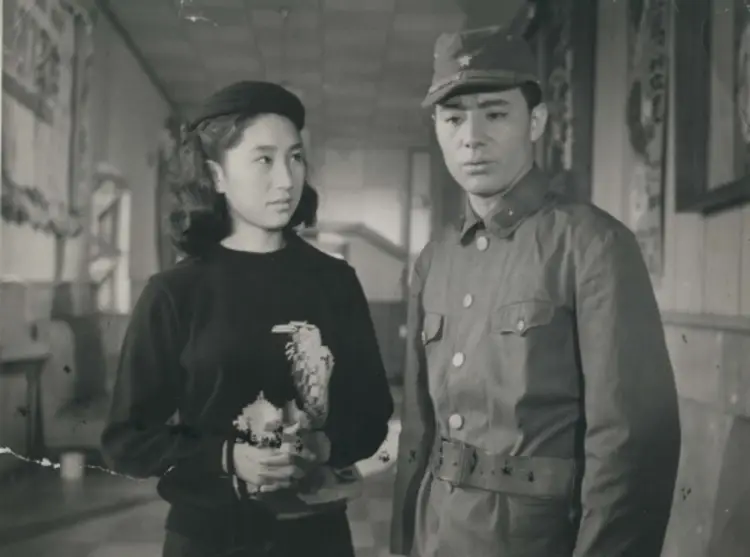The Sea Knows (현해탄은 알고 있다) 1961
‘The Sea Knows’ is a poignant melodrama created in 1961 by the visionary filmmaker Kim Ki-Young. The film stars Gong Midori, a talented Korean-Japanese actress, in the role of Hideko, a vibrant and spirited young Japanese woman. Opposite her is Kim Wun-ha as Aro-un, a Korean student soldier stationed in Nagoya during the turbulent times of 1944. Kim, having previously lived in Kyoto, developed a profound appreciation for Japanese culture and cinema, which he brought to his work.
To enhance the film’s authenticity, he, along with his cinematographer, Jung Il-Sung, journeyed to Nagoya to shoot transitional scenes, while the majority of the film’s footage was captured in Korea, featuring an all-Korean cast. This decision stemmed from the need to comply with government restrictions banning Japanese actors from South Korean films at the time. Following the film’s release, the government took further action, imposing even stricter regulations on filming in Japan.
In the narrative, Aro-un is presented as a troublesome student soldier, part of a group of Korean comrades training in Nagoya to ultimately join the ranks of the Japanese imperial army. His life takes a significant turn when Nakamura, a more compassionate senior officer, invites Aro-un to his sister’s home. Here, Aro-un stumbles upon a collection of books and is taken aback to learn they belong to Hideko, Nakamura’s niece. Hideko is portrayed as a dynamic young woman grappling with her biases; she initially harbours disdain towards Koreans, blaming them for a robbery that occurred at a neighbour’s home. However, when Nakamura reveals Aro-un’s Korean identity, she swiftly apologizes, yet a curious spark lingers in her gaze as she exits the room. Their paths cross once again at a local movie theatre, where Hideko takes an active stance in nurturing their fledgling romance.
Yet, beneath the surface of what could be seen as a conventional love story, the film dives deeply into Aro-un’s emotional turmoil and suffering. Aro-un and Hideko share an intellectual bond, as well as through the compassion that Hideko shows for the injustices Aro-un endures at the hands of his Japanese superiors, tying together sexual context with pain and suffering. In particular, Private Mori embodies the oppressive force that plagues Aro-un’s existence, subjecting him to relentless scrutiny and abuse. Meanwhile, Hideko struggles with her mother’s deeply ingrained anti-Korean sentiments, which creates a rift between them.
Unfortunately, ‘The Sea Knows’ reels have suffered from deterioration over time, marked by instances of silence and moments when the visuals vanish. Shot entirely in striking black and white, the film becomes increasingly graphic as it progresses, culminating in strong anti-war sentiments in a memorable conclusion.
The narrative profoundly emphasizes anti-war themes while illustrating the possibility of coexistence between the Japanese and Korean peoples. This theme is beautifully encapsulated through the evolving relationship of Hideko and Aro-un, who learn to view each other as individuals rather than representatives of national enmity. The most negatively portrayed characters are the barbaric Private Mori and Miyamura, who embody the traditional military mindset and uphold a destructive camaraderie that prevailed during this historical period. Korean audiences—predominantly female—are subtly urged by Kim to challenge their preconceived notions, mirroring the initial perspectives held by Hideko and her mother, encouraging them to see others as people of varying character instead of mere representatives of their countries.
Kim Ki-young masterfully balances various perspectives throughout the film, steering clear of a simplistic anti-Japanese narrative. At the time of its release, public sentiment in Korea was mixed; while anti-Japanese feelings remained prevalent, there was also a financial motivation driving a desire for improved relations between the two nations. Rather than veering into overt nationalism, the film presents moments of anti-Japanese sentiment that, while undeniably present, manage to avoid a caricatured or propagandistic portrayal. Though the film’s physical damage and quality issues diminish its overall impact, the strengths embedded within its narrative and emotional weight resonate powerfully with viewers.
